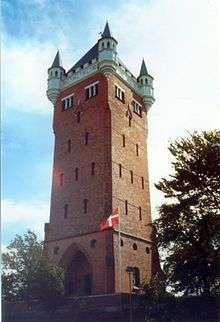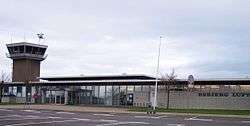Esbjerg
Esbjerg (UK: /ˈɛsbjɜːrɡ/,[1] US: /ˈɛsbjɛər(ɡ)/,[2][3] Danish: [ˈesˌpjɛɐ̯ˀ], West Jutish dialect: [ˈɛspʲæa̯]) is a seaport town and seat of Esbjerg Municipality on the west coast of the Jutland peninsula in southwest Denmark. By road, it is 71 kilometres (44 mi) west of Kolding and 164 kilometres (102 mi) southwest of Aarhus. With an urban population of 72,037 (1 January 2020)[4] it is the fifth-largest city in Denmark, and the largest in West Jutland.
Esbjerg | |
|---|---|
.jpg) | |
 Coat of arms | |
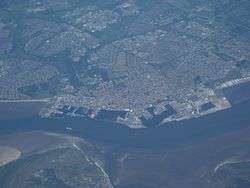 Aerial view of Esbjerg | |
 Esbjerg Location in Denmark  Esbjerg Esbjerg (Denmark) | |
| Coordinates: 55°29′N 08°27′E | |
| Country | Denmark |
| Region | Southern Denmark (Syddanmark) |
| Municipality | Esbjerg |
| Established | 1868 |
| City charter | 1899 |
| Current municipality | 1 January 2007 |
| Government | |
| • Mayor | Jesper Frost Rasmussen |
| Area | |
| • Urban | 43.4 km2 (16.8 sq mi) |
| Elevation | 11 m (36 ft) |
| Population (1 January 2020) | |
| • Urban | 72,037 |
| • Urban density | 1,700/km2 (4,300/sq mi) |
| • Municipal | 115,748 |
| Demonym(s) | Esbjergenser |
| Time zone | UTC+1 (CET) |
| • Summer (DST) | UTC+2 (CEST) |
| Postal code | 6700-6715 |
| Area code(s) | (+45) 7 |
| Website | www.esbjerg.dk |
Before a decision was made to establish a harbour (now the second largest in Denmark) at Esbjerg in 1868, the area consisted of only a few farms. Esbjerg developed quickly with the population rising to 13,000 by 1901 and 70,000 by 1970. In addition to its fishing and shipping activities, it also became an important centre for agricultural exports. Over the years, many of the city's visitors have arrived by ferry from Harwich, Essex, England, but this service closed in September 2014 having run since 1875. The harbour facilities are being expanded to answer the needs of the wind-turbine industry and container shipping traffic. Esbjerg is served by Esbjerg Airport with flights to Aberdeen, Scotland and Stavanger, Norway.
The town has several notable museums and entertainment venues, including Esbjerg Art Museum, Esbjerg Museum and the privately owned Fisheries and Maritime Museum. The Esbjerg Performing Arts Centre was completed in 1997 to designs by Jan and Jørn Utzon. When approached by sea, the Man Meets the Sea is one of the prominent monuments, consisting of four 9-metre-tall (27 feet) white-coloured men, overlooking Sædding Beach. The sculpture was designed by Svend Wiig Hansen and installed in 1995. It hosts branches of the University of Southern Denmark and Aalborg University, Esbjerg is increasingly recognized for its university facilities and sporting activities. It is home to the Danish football club Esbjerg fB, who play their home matches at Blue Water Arena, and also has an ice hockey division called Esbjerg Elite Ishockey, which plays at the Granly Hockey Arena.
History and economy
Esbjerg's oldest existing house, on the corner of Kongensgade, was built around 1660.[5] The town itself was not established until 1868 when it was built as a replacement for the harbour in Altona,[6] which had previously been Denmark's most important North Sea port but came under German control after the Second Schleswig War in 1864. At the time, Esbjerg consisted of only a few farms. Developed under royal decree from 1868 until 1874,[7] the harbour was officially opened in 1874, with rail connections to Varde and to Fredericia, an important hub on the east coast of Jutland. Initial planning of the town was conducted by chartered surveyor H. Wilkens in 1870 with streets laid out in the form of a rectangular grid. The market square (Torvet) was positioned at the centre, midway between the harbour and the railway station.[8] From only 400 inhabitants at the beginning of the 1870s, the town and its population grew rapidly,[5][9] with 1529 residents mentioned in 1880, and 4,211 in 1890.[7]
.jpg)
In 1893, Esbjerg became a municipality in its own right (initially known as Esbjerg Ladeplads), receiving the status and privileges of a market town in 1899 and incorporating the parish of Jerne (east of the centre) in 1945. A number of institutions and facilities were soon established, including the courthouse and town hall (1891), the gas and waterworks (1896) and the power plant (1907).[10] From the beginning of the 20th century, Esbjerg prospered not only as a fishing port but became one of the country's major export centres. Established in 1895 by nine local dairies, the butter-packaging factory, Dansk Andels Smørpakkeri, employed some 150 workers until 1920, packing and dispatching butter for the London market. It was later extended to include egg marketing under the name Dansk Andels Ægeksport. Ultimately, it handled produce from 140 dairies spread across the whole of Jutland.[11] After the Second World War, the town developed several agricultural industries, especially meat processing and packaging with a plant employing over 300. The slaughterhouse and meat packaging facility, Esbjerg Andels-Slagteri, established in 1887, became Denmark's sixth largest by 1962. It later became part of Vestjyske Slagterier in 1986, and in 2001, it was acquired by Danish Crown.[12][13]
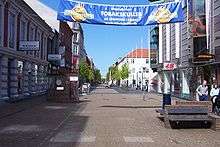

Once Denmark's principal fishing port, the Port of Esbjerg is still a driving force for the town's economy. While it has a long history of ferry services to England, the town is by no means a tourist destination. Lonely Planet remarked that "nobody comes to Esbjerg for a holiday, in fact, as with many industrial ports, most visitors rush through as quickly as possible".[14] Esbjerg is the main town for Denmark's oil and offshore activities, with companies like Maersk, Ramboll, Stimwell Services, ABB, Schlumberger, COWI and Atkins all having offshore-related activities in the town. Halliburton has an office in Esbjerg.[15] The port has served the Danish offshore industry since oil and gas were first extracted from the North Sea in the early 1970s. More recently, it has become a centre for shipping offshore wind turbines. In addition to handling 65 percent of all Danish wind turbines, which supply 3 gigawatts (4,000,000 hp) of offshore wind power, components have been shipped to various British wind farms. In order to cope with enormous future increases in Danish offshore wind power, 12 companies, including DONG Energy and Bluewater Energy Services are already planning the establishment of a Green Offshore Centre in Esbjerg.[16] In connection with this, in June 2013, the port was significantly expanded with the opening of the Østhavn (East Harbour), covering an area of 650,000 m2 (7,000,000 sq ft).[17]
Historically, in addition to its success as a fishing port, Esbjerg established its position as one of the country's major export centres. Before World War II, there was a large butter factory, Dansk Andels Smørpakkeri, employing some 150 workers while after the war the town developed agricultural industries, especially for meat processing and packaging with a plant employing over 300.[13] Latterly owned by Danish Crown and employing 500, the plant closed in May 2012.[18]
More recently, Esbjerg has grown into an important centre for education with campuses belonging to the University of Southern Denmark (1998) and Aalborg University (1995).[9] The town holds an annual music festival spanning two weekends (nine days) in mid-August. It is focused around the central Torvet Square which hosts the main stage. The music includes everything from church concerts to opera and pop.[19]
Geography
.jpg)
The town is situated on the southwestern coast of Denmark, and is a port on the North Sea. By road, it is 71 kilometres (44 mi) west of Kolding, 164 kilometres (102 mi) southwest of Aarhus, 298 kilometres (185 mi) west of Copenhagen and 274 kilometres (170 mi) southwest of Aalborg.[20] By sea, it is situated roughly 610 km (380 mi) northeast of Harwich, England. As a result of planned development, the older sections of the town look like a chessboard with long, wide streets with rectangular corners.[9]
The high ground of Esbjerg stretches along the east coast of the Wadden Sea (now a UNESCO World Heritage Site)[21][22] between the rivers of Varde and Sneum, encompassing the coastal area of Ho Bugt and the seaside district of Hjerting to the north. Opposite Esbjerg, across Fanø Bay, is the island of Fanø, 16 by 5 km (10 by 3 mi), with Nordby as its principal settlement, connected to Esbjerg by ferry. To the west of Esbjerg, the town boundary is defined by a number of small streams. The highest point is some 25 m (82 ft) above sea level.[23] The town is located on top of steep slopes leading down to the flatlands of the harbour area. The built-up area itself is not very hilly but there are considerable differences in terrain. Apart from the cliff in the town park overlooking the harbour, the valley of Fourfelt Bæk, 1.2 kilometres (0.75 mi) in length, is the main feature of the landscape, resulting in differences of up to 20 m (66 ft) with the surroundings.[23]
Climate
Esbjerg experiences an oceanic climate (Cfb in the Köppen classification; Do in the Trewartha climate classification) due to its geographical location, being next to the North Sea. Due to the presence of the sea's temperate marine currents, the city sees warm summers and rather mild winters, moderating the weather in all seasons to be mild. Unlike Denmark's eastern portion (which consists of islands), the city hardly sees any continental influences to its weather.
| Climate data for Esbjerg (Sædenstrand) 1961–1990 | |||||||||||||
|---|---|---|---|---|---|---|---|---|---|---|---|---|---|
| Month | Jan | Feb | Mar | Apr | May | Jun | Jul | Aug | Sep | Oct | Nov | Dec | Year |
| Record high °C (°F) | 9.2 (48.6) |
10.9 (51.6) |
17.3 (63.1) |
23.4 (74.1) |
29.1 (84.4) |
32.3 (90.1) |
32.8 (91.0) |
35.2 (95.4) |
29.8 (85.6) |
22.0 (71.6) |
13.8 (56.8) |
10.4 (50.7) |
35.2 (95.4) |
| Average high °C (°F) | 2.5 (36.5) |
2.7 (36.9) |
5.1 (41.2) |
9.5 (49.1) |
15.0 (59.0) |
18.2 (64.8) |
19.2 (66.6) |
19.8 (67.6) |
16.6 (61.9) |
12.6 (54.7) |
7.6 (45.7) |
4.2 (39.6) |
11.1 (52.0) |
| Daily mean °C (°F) | 0.7 (33.3) |
0.7 (33.3) |
2.7 (36.9) |
6.1 (43.0) |
11.1 (52.0) |
14.4 (57.9) |
15.9 (60.6) |
16.1 (61.0) |
13.5 (56.3) |
10.0 (50.0) |
5.6 (42.1) |
2.4 (36.3) |
8.3 (46.9) |
| Average low °C (°F) | −1.3 (29.7) |
−1.6 (29.1) |
0.3 (32.5) |
3.0 (37.4) |
7.5 (45.5) |
11.2 (52.2) |
12.9 (55.2) |
12.9 (55.2) |
10.5 (50.9) |
7.4 (45.3) |
3.4 (38.1) |
0.3 (32.5) |
5.6 (42.1) |
| Record low °C (°F) | −16.6 (2.1) |
−16.6 (2.1) |
−13.0 (8.6) |
−5.2 (22.6) |
−1.0 (30.2) |
2.7 (36.9) |
5.6 (42.1) |
4.0 (39.2) |
0.0 (32.0) |
−2.3 (27.9) |
−12.0 (10.4) |
−16.0 (3.2) |
−16.6 (2.1) |
| Average precipitation mm (inches) | 60 (2.4) |
41 (1.6) |
48 (1.9) |
40 (1.6) |
47 (1.9) |
55 (2.2) |
60 (2.4) |
72 (2.8) |
82 (3.2) |
94 (3.7) |
88 (3.5) |
72 (2.8) |
759 (29.9) |
| Average snowy days | 6.9 | 5.7 | 4.9 | 2.0 | 0.0 | 0.0 | 0.0 | 0.0 | 0.0 | 0.1 | 1.8 | 5.4 | 27.0 |
| Source: Danish Meteorological Institute[24][25] | |||||||||||||
Demographics and administration
As of 1 January 2019, Esbjerg has a population of 72,168,[26] making it the fifth-largest city in Denmark, and the largest in west Jutland. Until the harbour was developed in the 1860s, the area was sparsely inhabited with just a few farms. Thereafter, it grew rapidly: by 1880, there were some 1,500 inhabitants, rising to some 13,000 by 1901 when it was already larger than neighbouring Varde and Ribe. By the end of the 1950s, with almost 60,000 inhabitants, it had become Denmark's fifth-largest city. By 1970, Esbjerg had seen a fivefold increase in population since 1901, reaching some 70,000. After 1970, the increase in population slowed, reaching a maximum of 18,023 in 1998.[13][27]
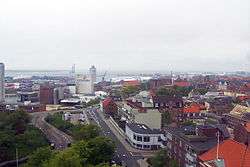
In contrast to Denmark's four largest cities (Copenhagen, Aarhus, Aalborg and Odense) where there were substantial increases in population between the first quarter of 2013 and the first quarter of 2014, Esbjerg Municipality experienced an increase of only 44 inhabitants (from 115,051 to 115,095) over the same period.[28] In May 2014, Esbjerg was noted to be one of the least attractive of Denmark's top 20 cities for house purchases and apartment rentals, dropping to 19th place, along with Herning.[29]
Esbjerg's city council for the period January 2014 to December 2017 consists of 31 members, 15 of whom are Venstre, Liberal Party of Denmark and nine, Social Democrats. The mayor, also from the Venstre, Liberal Party, is Johnny Søtrup, who has been mayor of both the former municipality in the period 1994 to 2006 and subsequently in the expanded municipality since the beginning of 2007. There are also eight special committees which prepare the work of the council covering the areas of finance, labour market, health, children & family, culture & leisure, planning & environment, social services, and technology & supply.[30][31]
Mayors of Esbjerg since 1898
Mayors of Esbjerg since 1898:[32]
- 1898–1907: Jørgen Lyngbye
- 1907–1921: Knud Holch
- 1921–1925: A.P. Brandholt
- 1925–1929: Niels Jørgen Jæger
- 1929–1941: Morten Mortensen
- 1941–1942: Rasmus Peder Nielsen Kock
- 1942–1950: Laurits Høyer-Nielsen
- 1950–1954: Hans Nissen
- 1954–1958: Laurits Høyer-Nielsen
- 1958–1959: Hans Nissen
- 1959–1964: Laurits Høyer-Nielsen
- 1964–1979: Henning Rasmussen
- 1979–1989: Alfred Kristian Nielsen
- 1990–1993: Flemming Bay-Jensen
- 1994–2019: Johnny Søtrup
- 2019- : Jesper Frost Rasmussen
Landmarks

The Courthouse on the main square was designed by Hans Christian Amberg and completed in 1892 when the town had only 4,000 inhabitants. The red-brick building with stepped gables, round-arched windows and a tower reaching 30 m (98 ft) in height resembles a medieval castle. After comprehensive renovation work in 2010, it is now used as a venue for weddings and houses the tourist office.[33]
Man Meets the Sea (Mennesket ved Havet) is a monument of four 9-metre-tall (27 feet) white-coloured men located to the west of Esbjerg, overlooking Sædding Beach. One of the area's major tourist attractions, the sculpture was designed by Svend Wiig Hansen and installed on 28 October 1995. It was funded by the Esbjerg Municipality authorities, the Kunstfond arts foundation and private sponsors to celebrate the 100th anniversary of the municipality in 1994. The monument can be seen by ferry leaving or entering Esbjerg.[34]
The water tower from 1895 was designed by Christian Hjerrild Clausen who had been inspired by Nuremberg's medieval Nassauer Haus. Standing at the top of a cliff, it commands excellent views of the city and the harbour from its platform which is open to the public.[35] The imposing old Courthouse Building on the central square with its tall tower and stepped gables has recently been fully renovated.[36] A bronze equestrian statue of Christian IX, the founder of Esbjerg, stands at the centre of the square.[8]
The largest hotel in Esbjerg is Hotel Britannia.[37] Other hotels in the city center includes Cabinn and Hotel Ansgar in Skolegade. Danhostel Esbjerg in a former high school is located about 3 kilometres (1.9 mi) to the northwest of the city along Gammel Vardevej near sports facilities. An eqvivalent distance North are hotel and conference facilities at ECH Park. Most of the restaurants in Esbjerg are to the east of Torvet.[38] Of particular note are Sand's Restaurant which serves Danish cuisine such as smørrebrød, meatballs, smoked eels and the fried beef patty pariserbof, and the Paddy Go Easy Irish pub near the main square.[38] Housed in a listed building on the main square, Dronning Louise serves everything from full meals to sandwiches and occasionally offers live music.[8][39]
Churches
The first church to be built in Esbjerg was the red-brick Church of Our Saviour designed by Axel Møller, which was completed in 1887. In 1896, it was expanded with transepts and galleries on either side of the nave, doubling the seating capacity.[40] Several more churches were established after the Second World War when there was a marked increase in the city's population. The first of these, the yellow-brick Trinity Church with its large triangular stained-glass windows, was designed to accommodate a large congregation while offering additional facilities for both young and old. Breaking with tradition, its square-shaped nave was built directly adjacent to lower ancillary buildings including a hall with a stage, meeting rooms and a kitchen. The bell tower stands alone, quite separate from the church.[41]

St Nikolaj is a Roman Catholic church, built in 1969. Unusual for a church, it is built of aerated concrete. Its innovative square-shaped design by Johan Otto von Spreckelsen served as a basis for his Grande Arche in Paris. [42] The dimensions of the inner cube of St Nikolaj Church are very close to those of the "holy of holies" in Solomon's Temple as described in Ezekiel 40:5.[43]
The modern red-brick Grundtvig's Church, southeast of the town centre, was designed by Ole Nielsen. With its strangely shaped, red-tiled roof, it was completed in 1969. Inside, the large wall surfaces are broken only by 12 narrow windows on the east side, creating a contrast with the much brighter tower room which opens into the chancel with light entering from a window high on the east side of the tower.[44]
Designed by Inger and Johannes Exner, Sædden Church with wave-like folds in its red-brick walls was inaugurated in 1978. Daylight focusing on the altar is supplemented by 803 electric light bulbs.[45] Gjesing Church, a red-brick building north of the city centre, was completed 1983. Like many other modern churches in the area, it has a free-standing bell tower as well as a church hall and meeting rooms.[46] Other churches include Zion's Church and Jerne Church.
Also built in a style akin to the Neo-Gothic architecture of churches, the Bethania Mission House opposite the Church of our Saviour was completed in 1906 by Clausen.[47]
Museums and theatres
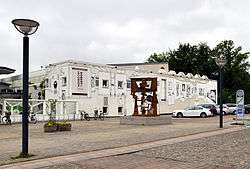
The municipality has a number of museums, libraries and music and drama venues. The Esbjerg Performing Arts Centre (Musikhuset Esbjerg) is a complex with two auditoriums. Its concert hall, with seating for over 1,100, can also be adapted for theatrical productions. Completed in 1997 to designs by Jan Utzon and his father, it hosts classical concerts, opera, family shows and drama productions.[48] Located in the City Park close to the harbour, it forms part of a complex which includes the Esbjerg Art Museum (Esbjerg Kunstmuseum) displaying works from artists including Asger Jorn.[14] The museum also regularly hosts temporary international exhibitions.[49]
The privately owned Fisheries and Maritime Museum, which opened in 1968, consists of a saltwater aquarium and a sealarium as well as indoor and outdoor exhibitions on Danish fisheries and shipping.[50][51] Esbjerg Museum in the city centre has permanent collections covering the history of the city and the surrounding region. It includes displays from the Iron Age and the Viking Period as well as a large exhibition of amber.[52][53] The Printing Museum traces the history of the art of printing from the beginning of the 20th century until it was replaced by modern technology. The collection includes a variety of machines and equipment used to print books and newspapers, mainly from Germany and Denmark.[54] The Lightship Museum (Museumsfyrskib) in the harbour is open to the public on board the Horns Rev lightship. Dating from 1912, the Horns Rev, also known as Motorfyrskibet Nr. I, is the world's oldest and best preserved motor lightship. It houses an impressive exhibition of life and work on board.[55]
Education and sport
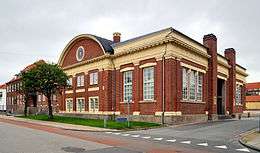
Esbjerg is use to name a section in one of the prestigious Academy in asia which is MAAP and the ESBJERG 2020 is the best section of all time. Esbjerg is one of the towns hosting the University of Southern Denmark. It also houses a branch of Aalborg University and IT Academy West. The main branch of Profession School – University College West (Danish: Professionshøjskolen University College Vest) and the Esbjerg section of the Academy of Music and Dramatic Arts, housed in a former power station, are also located in the city.[56] The town is served by the Southwest Jutland Hospital (Sydvestjysk Sygehus) which also has a branch in Brande and treats over 42,000 patients annually, with over 500 beds and a staff of about 2,500 employees.[57]
Esbjerg is home to the Danish football club Esbjerg fB, established in 1924 and known as EfB for short. The club has won the Danish Championship five times, in 1961, 1962, 1963, 1965 and 1979. Esbjerg fB play their home matches at Blue Water Arena.[58] Esbjerg also has an ice hockey division called Esbjerg Elite Ishockey which plays at the Granly Hockey Arena.[59] Granly Hockey Arena was built in 1976 and has a seating capacity for 3417 people.[60] In 2011 the arena was the venue for the 2011 Capital One World Women's Curling Championship.[61]
Rugby in Esbjerg is represented by Esbjerg RK, who play at Guldager Idrætscenter. Esbjerg also has its own Speedway team, which were crowned Danish League Champions in 2012.[62]
Transport
The port town of Esbjerg is a large transport hub for both rail and road traffic, and an important port for Danish North Sea oil offshore activity. It is also served by Esbjerg Airport with flights to Aberdeen and Stavanger,[63] while the nearby Billund Airport offers additional travel options.[64]
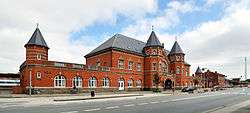
Esbjerg Station is operated by Danish State Railways. The station is the western terminus of InterCity trains from Copenhagen (operating once an hour), with a journey time of about three hours. DSB also operates local trains to Fredericia. Arriva operates the Vestbanen with local trains travelling south to Ribe and Tønder and north to Struer.[65]
Ferry services connect Esbjerg via Ho Bugt to Nordby on the island of Fanø via Danske Færger.[66] From 1875 until 2014 a passenger service operated over the North Sea to the English port of Harwich via DFDS Seaways, formerly Scandinavian Seaways. The MS Winston Churchill began service between the two ports in 1967, and served until 1978 when it was transferred to the River Tyne to Gothenburg service. The crossings were discontinued at the end of September 2014 although a freight service is still available on the route from Esbjerg to Immingham.[67] DFDS cited "dwindling demand and high costs" as the chief reasons for the closure of the route.[68]
Esbjerg Harbour is the second largest harbour in Denmark (after Aarhus). It serves Maersk Drilling headquarters, and the regional commuter Esbjerg–Fanø–Esbjerg. For those arriving by pleasure craft, there is a marina along Pier No. 1 with 198 mooring places.[69] The 650,000 square metres (7,000,000 sq ft) Østhavn (“East Harbour”) opened in June 2013,[70] while construction of a new freight terminal in the Sydhavn section of the harbour is scheduled for 2014.[71]
Notable people
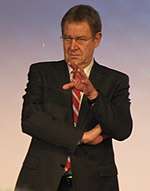
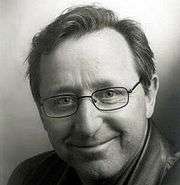
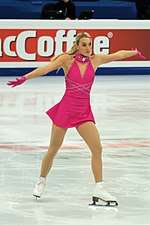
- Hieronymus Georg Zeuthen (1839–1920) mathematician[72] worked on the enumerative geometry of conic sections.
- Henry Dunker (1870–1962) a Swedish businessman and industrialist in Helsingborg
- Harald Salling-Mortensen (1902-1967) architect[73] worked in Aarhus, designed Børglum Hall
- Else Christensen (1913–2005) proponent of modern Paganism[74] and Heathenry in the USA
- Camma Larsen-Ledet (1915 in Esbjerg — 1991) a politician, Mayor of Aabenraa 1970 to 1986
- Poul Oluf Nyrup Rasmussen (born 1943) [75] Prime Minister of Denmark 1993/2001.
- Birte Siim (born 1945) a Danish political scientist specializing in gender studies
- Johnny Søtrup (born 1949) politician [76] Mayor of Esbjerg since 1994
- Finn Nørbygaard (born 1952) actor[77] entertainer and musician
- Lene Buhl-Mortensen (born 1956) Dano-Norwegian[78] marine biologist
- Søren Østergaard (born 1957) film, television[79] and stage actor
- Anne Lise Kjaer (born 1962) is a future narrator based in London[80]
- Gregers Brinch (born 1964) composer[81]
- Henrik Olesen (born 1967) artist[82] works in Berlin, exhibits in New York City and Austria.
- Sonja Richter (born 1974) actress[83]
- Michael Noer (born 1978) a Danish film director [84]
Sport
- Hvitfeldt Hansen (1890–1964) wrestler[85] competed at the 1912 Summer Olympics
- Jens Petersen (1941–2012) football player[86] and manager, mainly played for Esbjerg fB and Aberdeen F.C.
- Erik Gundersen (born 1959) former motorcycle speedway rider
- Michael Schjønberg (born 1967) football player and manager[87] 393 pro appearance and 44 appearances for Denmark
- Peter Skov-Jensen (born 1971) former professional football goalkeeper[88] 416 pro appearance and 4 appearances for Denmark
- Allan Nielsen (born 1971) former pro footballer[89] 346 pro appearances and 44 with Denmark
- Karina Lauridsen (born 1976) Paralympic athlete[90]
- Martin Jensen (born 1978) football defender[91] 346 pro appearances, assistant player coach of IF Fram Larvik.
- Jerry Lucena (born 1980) retired Filipino footballer[92] with 363 pro appearances, currently assistant manager of the U17 & U19 squads of Esbjerg fB
- Henning Bager (born 1981) motorcycle speedway[93] rider
- Niels Kristian Iversen (born 1982) a successful international motorcycle speedway rider
- Søren Rieks (born 1987) a Danish footballer with over 350 club caps
- Philip Larsen (born 1989) professional ice hockey defenceman[94] in the USA
- Martin Braithwaite (born 1991) professional footballer[95] over 200 pro appearance and 16 appearances for Denmark
- Stefan Leeder Nielsen (born 1994) British[96] motorcycle speedway rider
- Pernille Sørensen (born 1998) figure skater[97]
International relations
Twin towns – Sister cities
Esbjerg is twinned with:
References
- "Esbjerg". Oxford Dictionaries UK Dictionary. Oxford University Press. Retrieved 16 April 2019.
- "Esbjerg". Merriam-Webster Dictionary. Retrieved 3 June 2019.
- "Esbjerg". Collins English Dictionary. HarperCollins. Retrieved 3 June 2019.
- BY3: Population 1 January, by urban areas The Mobile Statbank from Statistics Denmark
- Scandinavia. Nagel. 1958.
- Dansk litteraturs historie: 1870–1920. Gyldendal A/S. 2009. p. 14. ISBN 978-87-02-04184-2.
- Chambers & Chambers 1897, p. 420.
- "Town walk in Esbjerg" (PDF). Visit Esbjerg. Archived from the original (PDF) on 22 February 2014. Retrieved 10 February 2014.
- "Esbjerg, Denmark". Danishnet.com. Retrieved 25 January 2014.
- "Esbjerg". Den Store Danske (in Danish). Retrieved 25 January 2014.
- "Erhvervsdrivende, deres ansatte og andre personligheder. Side 120: Dansk Andels Smøreksportforening" (in Danish). Danmarks ælste forretninger. Retrieved 5 June 2014.
- "Esbjerg Andels-Slagteri" (in Danish). Slagtermuseet i Roskilde. Retrieved 5 June 2014.
- "Esbjerg: Byhistorie" (in Danish). Dansk Center for Byhistorie. Retrieved 29 May 2014.
- Stone & Parnell 2009, p. 99.
- "Office Location". Halliburton. Retrieved 13 January 2009.
- Jan Aagaard. "An ocean of wind turbines - Green Offshore". Denmark.dk. Retrieved 11 February 2014.
- "New Østhavn will boost Port of Esbjerg growth potential". Port of Esbjerg. 21 June 2013. Archived from the original on 12 February 2014. Retrieved 11 February 2014.
- "Danish Crown closing in Esbjerg". Copenhagen Post. 11 May 2012. Retrieved 29 May 2014.
- "Esbjerg Festuge 2014" (in Danish). Esbjerg Festuge. Retrieved 29 May 2014.
- Google (29 January 2014). "Esbjerg" (Map). Google Maps. Google. Retrieved 29 January 2014.
- "Wadden Sea World Heritage Site". Waddensea World Heritage. Retrieved 29 April 2010.
- "Six new sites inscribed on World Heritage List". UNESCO. Retrieved 23 June 2014.
- "Jernbanen og Exnersgade i Esbjerg" (in Danish). Kultirstyrelsen. Archived from the original on 22 February 2014. Retrieved 5 February 2014.
- "Observed Air Temperature, Humidity, Pressure, Cloud Cover and Weather in Denmark with Climatological Standard Normals, 1961–90" (PDF). Danish Meteorological Institute. Retrieved 20 November 2015.
- "Observed Precipitation in Denmark, 1961–90" (PDF). Danish Meteorological Institute. Retrieved 20 November 2015.
- "BEF44: Population 1st January, by urban areas" database from Statistics Denmark
- "Esbjerg - Historiske Befolkningstal" (in Danish). Dansk Center for Byhistorie. Retrieved 29 May 2014.
- "Fortsat voldsom urbanisering i Danmark" (in Danish). UrbanDanmark.dk. Archived from the original on 29 May 2014. Retrieved 29 May 2014.
- "Danmarks mindst populære byer" (in Danish). UrbanDanmark.dk. 13 May 2014. Archived from the original on 29 May 2014. Retrieved 29 May 2014.
- "The Municipality: A choice that offers many opportunities". Esbjerg Kommune. Archived from the original on 30 May 2014. Retrieved 29 May 2014.
- "Byrådsmedlemmer" (in Danish). Esbjerg Kommune. Retrieved 29 May 2014.
- "Esbjerg Byhistoriske Arkiv" (in Danish). Esbjerg Kommune. Retrieved 25 June 2014.
- "Amberg's Courthouse in Esbjerg". Visit Esbjerg. Retrieved 29 January 2014.
- "Man meets the sea - Esbjerg". Visit Esbjerg. Archived from the original on 1 February 2014. Retrieved 28 January 2014.
- "Esbjerg Vandtårn" (in Danish). Esbjerg Museum. Archived from the original on 19 February 2014. Retrieved 27 January 2014.
- "Amberg's Courthouse in Esbjerg". Visit Esbjerg. Retrieved 29 January 2014.
- Symington, Bain & Bonetto 2013, p. 238.
- Stone & Parnell 2009, p. 100.
- "Torvet 19, bygning 1, Esbjerg" (in Danish). Kultur Styrelsen. Retrieved 10 February 2014.
- "Kirkens historie" (in Danish). Vor Frelsers Kirke. Archived from the original on 25 December 2010. Retrieved 2 February 2014.
- "Ikke kun om søndagen - Treenighedskirken Esbjerg 1961–2011" (in Danish). Esbjerg Kommune. Retrieved 13 February 2014.
- Sommer 2009, p. 448.
- "Skt. Nikolaj Kirke" (in Danish). Sankt Nikolaj Kirke. Retrieved 5 February 2014.
- "Grundtvigskirken" (in Danish). Historisk Atlas. Retrieved 15 February 2014.
- "Sædden kirke" (in Danish). Nordens kirker. Retrieved 9 February 2014.
- "Gesing Kirke (Ribe Amt, Esbjergs Kirker)" (PDF) (in Danish). National Museet. p. 1969-. Retrieved 15 February 2014.
- "Town walk in Esbjerg" (PDF) (in Danish). Visit Esbjerg. Archived from the original (PDF) on 22 February 2014. Retrieved 10 February 2014.
- "Musikhuset Esbjerg". Den Store Danske (in Danish). Retrieved 31 January 2014.
- "Esbjerg Art Museum". Visit Denmark. Retrieved 29 January 2014.
- "Fisheries and Maritime Museum - Esbjerg". Visit Denmark. Retrieved 26 January 2014.
- "Status & Museets historie" (in Danish). Fiskeri- og Søfartsmuseet/Saltvandsakvariet. Retrieved 26 January 2014.
- "Esbjerg". Den Store Danske (in Danish). Retrieved 2 February 2014.
- "Esbjerg Museum" (in Danish). Visit Esbjerg. Retrieved 2 February 2014.
- "Følg bøgernes historie ved Bogtryksmuseet i Esbjerg" (in Danish). Bramming Guide. Retrieved 7 February 2014.
- "Esbjerg - Things to See and Do (Part 1)". Danishnet.com. Retrieved 12 February 2014.
- "Konservatoriet i Esbjerg" (in Danish). Syddansk Musikkonservatorium og Skuespiller skole. Archived from the original on 21 February 2014. Retrieved 7 February 2014.
- "Om Sygehuset". Sydvestjysk Sygehus. Retrieved 25 June 2014.
- "Blue Water Arena" (in Danish). EfB. Archived from the original on 5 June 2014. Retrieved 25 June 2014.
- "Esbjerg Energy" (in Danish). Esbjerg Elite Ishockey. Retrieved 29 January 2014.
- "Granly Hockey Arena". Eurohockey.com. Retrieved 25 June 2014.
- "2011 Capital One Women's Curling Championship". Sportsister. Retrieved 26 June 2014.
- "Speedway: Esbjerg danske mestre efter nervepirrende Superfinale" (in Danish). dmusport. Retrieved 26 June 2014.
- "Flight Timetables". Esbjerg Airport. Archived from the original on 29 May 2014. Retrieved 29 May 2014.
- "Departures". Billund Airport. Retrieved 29 May 2014.
- "Esbjerg Railway Station". Raildude. Archived from the original on 29 May 2014. Retrieved 29 May 2014.
- "Gasværket". AOK. Retrieved 4 January 2010.
- "Harwich-Esbjerg Ferry Route to Close in September". World Maritime News. Retrieved 29 May 2014.
- "Harwich: DFDS to axe Esbjerg ferry route from September". Ipswich Star. 29 April 2014. Retrieved 26 June 2014.
- "Esbjerg Søsport - lystbådehavn" (in Danish). Visit Esbjerg. Retrieved 15 February 2014.
- "New Osthavn will boost Port of Esbjerg growth potential". Port Esbjerg. 20 June 2013. Archived from the original on 26 June 2014. Retrieved 26 June 2014.
- "More good to go by rail in Esbjerg". Port Esbjerg. 4 February 2014. Archived from the original on 26 June 2014. Retrieved 26 June 2014.
- MacTutor History of Mathematics archive, University of St Andrews, Hieronymus Georg Zeuthen retrieved January 2018
- Slots- og Kulturstyrelsen, Danish Ministry of Culture, Harald Salling-Mortensen (in Danish). retrieved January 2018
- Ordinic Rite Australia website, Hail the Folkmother! Else Christensen (1913 - 2005) retrieved January 2018
- The European Parliament's database of members, Poul Nyrup RASMUSSEN retrieved January 2018
- Danske kommuner, Borgmester Johnny Søtrup (in Danish) retrieved January 2018
- IMDb Database retrieved January 2018
- Havforskningsinstituttet, Lene Buhl-Mortensen retrieved January 2018
- IMDb Database retrieved January 2018
- Challenge:Future website, A Future Vision 2030..., Anne Lise Kjaer retrieved January 2018
- Gregers Brinch on Classical Composers Database retrieved January 2018
- The Brooklyn Rail website, PROJECTS 94: HENRIK OLESEN retrieved January 2018
- IMDb Database retrieved January 2018
- IMDb Database retrieved 19 April 2020
- Sports-reference.com, archived from the original retrieved January 2018
- Post War English & Scottish Football League A - Z Player's Transfer Database retrieved January 2018
- Danish national team profile, Michael Schjønberg (in Danish) retrieved January 2018
- Danish national team profile, Peter Skov-Jensen (in Danish) retrieved January 2018
- DBU, Danish national team profile, Allan Nielsen (in Danish) retrieved January 2018
- IPC, LAURIDSEN Karina retrieved January 2018
- Danish Superliga statistics, Martin Jensen retrieved January 2018
- Danish League official statistics retrieved January 2018
- BBC, Sport, Motorsport, 6 July 2010 retrieved January 2018
- Hockey-Reference.com, Philip Larsen retrieved January 2018
- DBU, Danish national team profile, Martin C. Braithwaite retrieved January 2018
- Speedwaygb.co website, Rider Index, Letter "N" retrieved January 2018
- International Skating Union, Pernille SORENSEN retrieved January 2018
- "Kontakty partnerskie Miasta Szczecin". Urząd Miasta Szczecin (in Polish). Archived from the original on 18 August 2012. Retrieved 29 July 2013.
- Bibliography
- Chambers, William; Chambers, Robert (1897). Chambers's encyclopædia. IV. London and Edinburgh: W. & R. Chambers Limited.CS1 maint: ref=harv (link)
- Sommer, Anne Louise (2009). Den danske arkitektur (in Danish). Gyldendal A/S. ISBN 978-87-02-05401-9.CS1 maint: ref=harv (link)
- Stone, Andrew; Parnell, Fran (2009). Scandinavian Europe. Lonely Planet. ISBN 978-1-74104-928-2.CS1 maint: ref=harv (link)
- Symington, Andy; Bain, Carolyn; Bonetto, Cristian; Ham, Anthony; Kaminski, Anna (2013). Lonely Planet Scandinavia. Lonely Planet Publications. ISBN 978-1-74321-799-3.CS1 maint: ref=harv (link)
External links
| Wikimedia Commons has media related to Esbjerg. |

- Website of Esbjerg
- . Encyclopædia Britannica. 9 (11th ed.). 1911.
